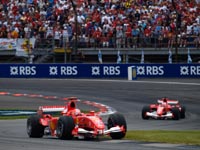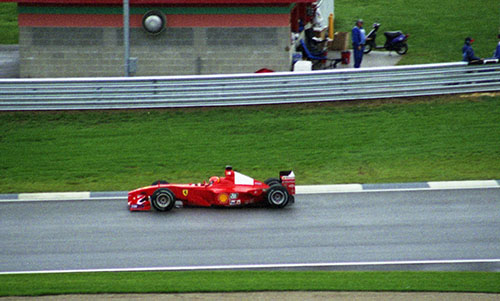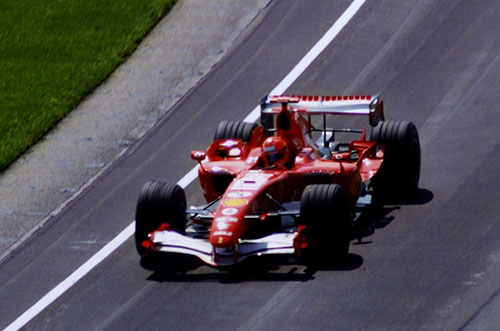Ferrari at Indianapolis: mutual love unanswered
2000-2007: It's Indy, Gino, but not as we know it
Author
- Henri Greuter
Date
- May 22, 2013
Related articles
- March-Porsche 90P - The last oddball at the Indianapolis Motor Speedway, by Henri Greuter
- March-Alfa Romeo 90CA - Fiasco Italo-Brittanico, by Henri Greuter
- The Race of Two Worlds - The 1958 "Monzanapolis" bash, by Darren Galpin
- Ferrari at Indianapolis, by Henri Greuter
- 1951: Ferrari and Indianapolis
- 1952: Ferrari at Indianapolis
- 1956: A 'hybrid' against one of Indy's most persistent jinxes
- 1958: At home against Indycars
- 1961-1968: of phantoms and enfants terribles
- 1971-1973: 'Meet my uncle Franco'
- 1975: A loud insect never leaving the chrysalis as was intended and hoped forů
- Intermezzo: Ferrari and turbocharging
- 1986: Projects 034 and 637, mere blackmail tools?
- Appendix: The cars
Who?Michael Schumacher, Rubens Barrichello What?Ferrari F2005 (656) Where?Indianapolis When?2005 United States GP (June 19, 2005) |
 |
Why?
Ferrari had to wait until 2000 for its first participation at Indy since that 1952 Indy effort by Ascari, although it wouldn't be for a '500'. Tony George managed to negotiate a deal with Bernie Ecclestone to have the US Grand Prix held on the Speedway. Only a third of the oval was used while a road course of some sort was created on the infield. This track was eventually used for the US GP for a period of eight years, from 2000 to 2007.

Indy's inaugural GP was won by Michael Schumacher. The weather on race day was dark and rainy, and it was a most unusual thing to see cars race in wet conditions on the IMS track. The conditions certainly didn't help with taking sharp pictures with a telelens high up in the grandstands... (photo HG)
In these eight years, Ferrari was to be the most successful team, winning the most races. But not all of Ferrari's victories came without controversy.
In 2002, a season in which Ferrari was utterly dominant, particularly in race conditions, Michael Schumacher appeared to have the race the race in the bag, only to give the victory away to team mate Rubens Barrichello in the dying moments of the race. Schumacher explained he had tried to make it a dead heat. This wasn't the first occasion, however, in recent history in which Ferrari fixed the race results (think of Austria 2001 and 2002) so the ploy wasn't well-received. A number of die-hard Indy fans felt insulted that a driver had given away victory at the Speedway while in the past drivers had literally died in their quest to be victorious on the same hallowed track.
In 2005, the majority of the starting field used Michelin tyres in a year in which tyre changes during the race were forbidden. Ferrari and backmarker teams Midland and Minardi were the only ones using Bridgestone tyres. The Bridgestones were inferior to the Michelins all year long but at Indy, the Michelins couldn't cope with the conditions that the Speedway demanded: they were dangerously unstable. Yet again, the Bridgestones were too slow but at least didn't have the durability and reliability problems that the Michelins suffered from. The Bridgestone cars were pretty much the turtles that at least could make it to the end.
No compromise to somehow make it a regular and safe race could be reached so after the warm-up lap every Michelin-shod car pulled back into the pits and only the six Bridgestone-shod cars started and finished the race, the Ferraris in the first two places. The uproar about this race result was tremendous, Ferrari receiving a lot of criticism that afternoon, which did the sport little good.
What made it such a fiasco was that Ferrari was the only top team not using Michelins. Midland and Minardi were no serious contenders, so with the withdrawal of all Michelin teams the race was gone. Had Bridgestone been forced to order their three teams to withdraw after the warm-up lap enough competitors would have been left to make it a decent race, and much less people would have cared about six cars having to withdraw. Furthermore, how many of those people would have been happy to see such an embarrassment befall to Ferrari, and Michael Schumacher in particular? The more after five years in which Ferrari had won both the constructors and drivers titles, occasionally hard-fought (2000 and 2003), sometimes with a bit less of work (2001) and twice with such a stunning domination (2002 and 2004) that pretty much all excitement in those seasons was killed, since apart from the opposition being outclassed on race day there was little to no contest between the two Ferrari drivers either. The team's efforts were centered around Michael Schumacher, with Rubens Barrichello acting as a clear number two. Besides all that, despite (or because?) of the dominance there were too much moments of controversy in those years, and just like the Ferrari haters many neutral race fans had enough of the Ferrari dominance and didn't mind or even rejoiced in the fact that the Italians were humiliated during that 2005 season. So there was little sympathy, let alone understanding for Ferrari's (and Bridgestone's) plight now they finally had a chance to show the world that this time Bridgestone had done the better job.
Bridgestone had dropped the ball massively in 2005 so a withdrawal from the race would have fitted pretty well. Regrettably for almost everyone, the situation was that the tyre company who had done the best job and had the most teams as their customers failed only once that season, but that failure was much more painful and with much more consequences than F1 was able to handle, causing the bad feelings that exploded over the 2005 Indy GP.
When we discard the 2005 race as a farce, Ferrari won five of the remaining seven US GPs at the Speedway.

One year after the Michelin fiasco a decent race took place at the Speedway but by then the controversy was about the sudden disallowance of the so-called mass dampers. Without them, Renault lost its dominant position that season and it certainly helped Ferrari to win yet another race at the Speedway. By that time F1 cars got ever more flaps, vanes, and winglets. (photo HG)
Four of those were doubles. In fact, of the seven 'genuine' Indy GPs Ferrari won five and also claimed five seconds and a third place, missing out on the podium on only three occasions. They also had five pole positions to boost in those seven real F1 races which means that they were by far the most successful team in the years that Indy played host to F1.

Definitely Indy, no doubt about it. But still, it is different from Indy as we know it best. (photo HG)
However, for many American race fans and Indy fans worldwide the one race held at Indianapolis counting above all the others is the 500. And Ferrari's record in the 500 remains a poor one, primarily consisting of one 'what if' after the other...
